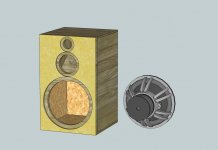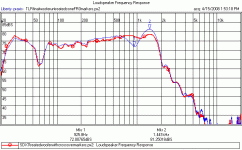You were near 2 reflections that were less than 0.4m away? Was it an infinite baffle?
No need to worry about keeping me happy. I've got a "measurement blip" in my measurement system at 20khz. It's a bad soundcard calibration I haven't gotten around to fixing. So I just wanted to understand how the information is derived.
I look forward to seeing the updated sheet
No need to worry about keeping me happy. I've got a "measurement blip" in my measurement system at 20khz. It's a bad soundcard calibration I haven't gotten around to fixing. So I just wanted to understand how the information is derived.
I look forward to seeing the updated sheet
Last edited:
Test baffle size is stated.
And yes. As I stated it was that distance away. I could barely swing a mic without hitting things. To many projects on the go in the shop and not enough room to do a proper measurement. It's almost warm enough to do outside measurements. That will change everything.
And yes. As I stated it was that distance away. I could barely swing a mic without hitting things. To many projects on the go in the shop and not enough room to do a proper measurement. It's almost warm enough to do outside measurements. That will change everything.
Ok, maybe this. My PDF won't attached, so formatting might be odd.
Frequency Response Measurement Report of CSS LD25x
Driver: CSS LD25x 25mm fabric dome tweeter
Measurement Conditions: 1m microphone distance
300 x 300mm baffle (tweeter recessed)
HolmImpulse
Calibrated Behringer ECM8000
Part 1 – On Axis Comparison
Sample B (red) vs Reference Tweeter (blue)

Sample A (blue) vs Sample B (red)
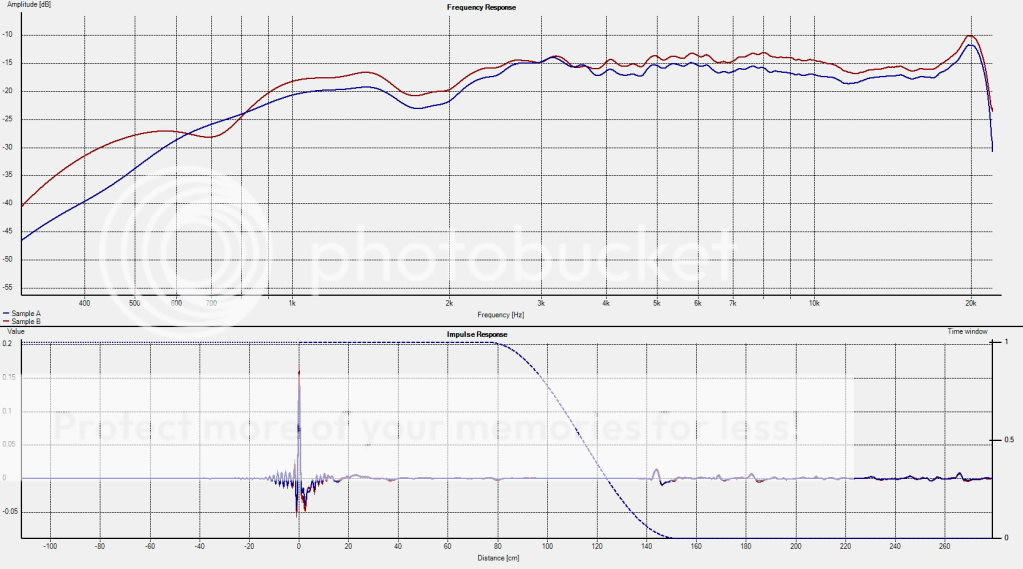
Note the response of the LD25x changed here. This is because the measurement setup changed to get the following measurements. The baffle was supported by a reflective turntable and the sound card calibration file was incorrect. These measurements are for comparative purposes.
Part 2 – Off Axis Response (Sample B)
0, 5, 10 degrees
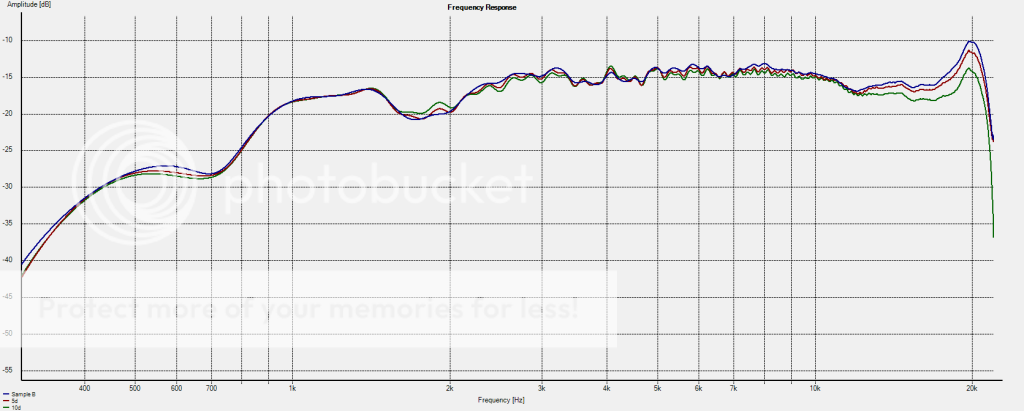
15, 30, 45 degrees
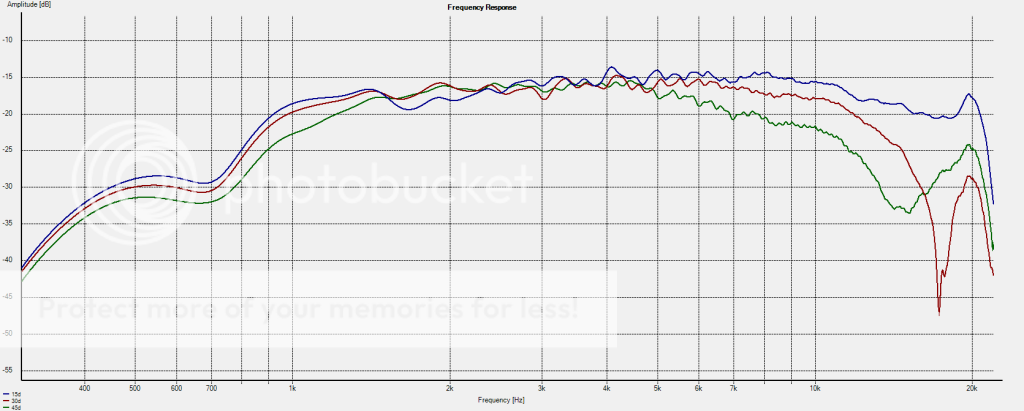
45, 60, 90 degrees
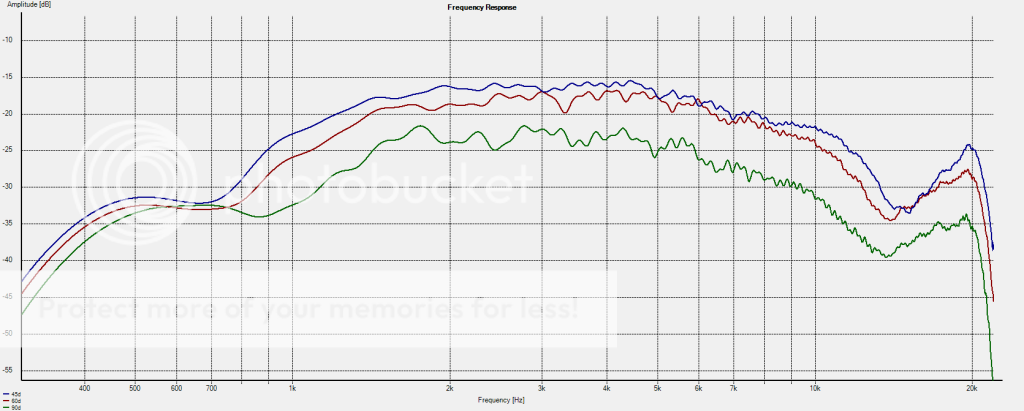
135 and 180 degrees were dominated by reflected sound only.
Polar Response

Part 3 – Filtered Responses (Sample B)
1, 2, 3uF series capacitor

3.9, 4.9, 5.9uF series capacitor
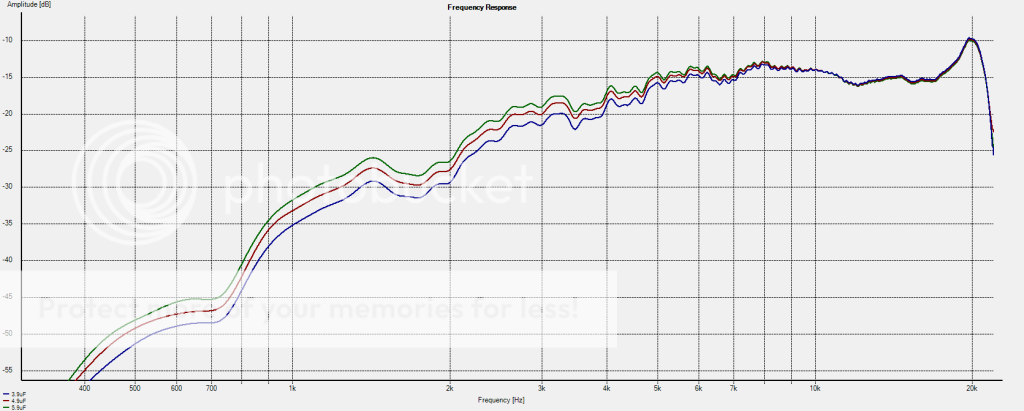
Part 4 – Power Compression Linearity (For this test, a 5.9uF and 0.45mH filter was in place. Wattage is approximate and based on a start voltage of 2.83V. Less than 1 second sweeps) (Sample B)
1w (blue) vs 4w (green)
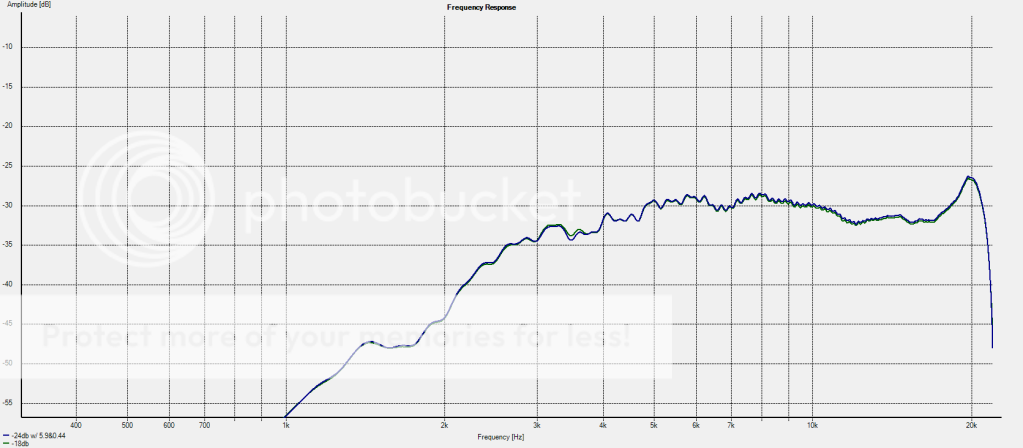
1w(red) vs 16w (blue)
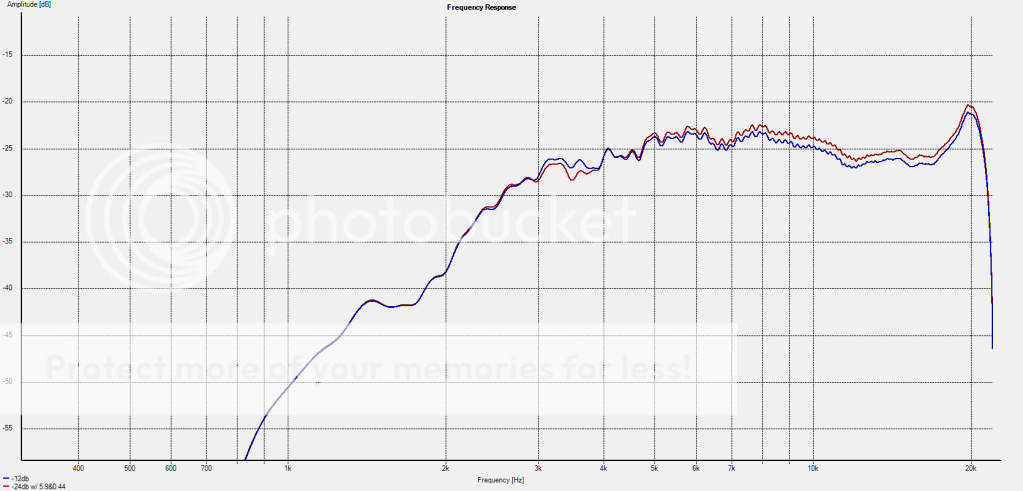
1w(blue) vs 32w (red)
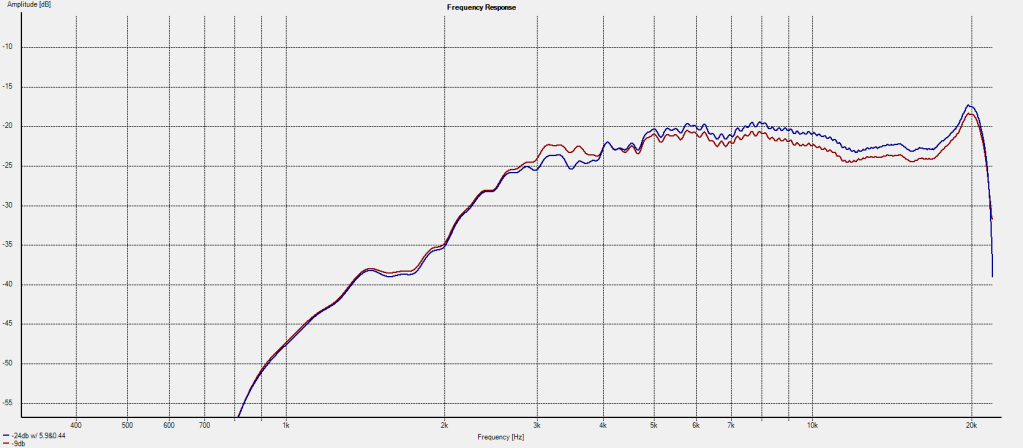
Report End
Frequency Response Measurement Report of CSS LD25x
Driver: CSS LD25x 25mm fabric dome tweeter
Measurement Conditions: 1m microphone distance
300 x 300mm baffle (tweeter recessed)
HolmImpulse
Calibrated Behringer ECM8000
Part 1 – On Axis Comparison
Sample B (red) vs Reference Tweeter (blue)

Sample A (blue) vs Sample B (red)

Note the response of the LD25x changed here. This is because the measurement setup changed to get the following measurements. The baffle was supported by a reflective turntable and the sound card calibration file was incorrect. These measurements are for comparative purposes.
Part 2 – Off Axis Response (Sample B)
0, 5, 10 degrees

15, 30, 45 degrees

45, 60, 90 degrees

135 and 180 degrees were dominated by reflected sound only.
Polar Response

Part 3 – Filtered Responses (Sample B)
1, 2, 3uF series capacitor

3.9, 4.9, 5.9uF series capacitor

Part 4 – Power Compression Linearity (For this test, a 5.9uF and 0.45mH filter was in place. Wattage is approximate and based on a start voltage of 2.83V. Less than 1 second sweeps) (Sample B)
1w (blue) vs 4w (green)

1w(red) vs 16w (blue)

1w(blue) vs 32w (red)

Report End
does anyone have a Sketchup model of these drivers?
anyone else? or another 3D model that can somehow be imported into Sketchup? from the looks of it, there is a 3D CAD drawing on the datasheets...Nope
no, just want to make my sketchup model of the 3way I'm developping with these (+SDX10) a bit nicerIs there a specific dimension you need or something?
yup, thanks.Henkjan send me a PM and I can set you up with what we have. The woofer is not sketchup , the tweeter is.
teaser:Wow, nice!... the 3way I'm developping with these
Attachments
LD25x in a waveguide
Hey,
I've been playing with some waveguides from CSS (planned for production I believe) for the LD25x. Dave P over on Tech Talk developed them. I had a speaker that uses the Dayton 8" waveguide and SB29 tweeter. This waveguide was a direct drop in. Take a look:
Before (Dayton and SB29)
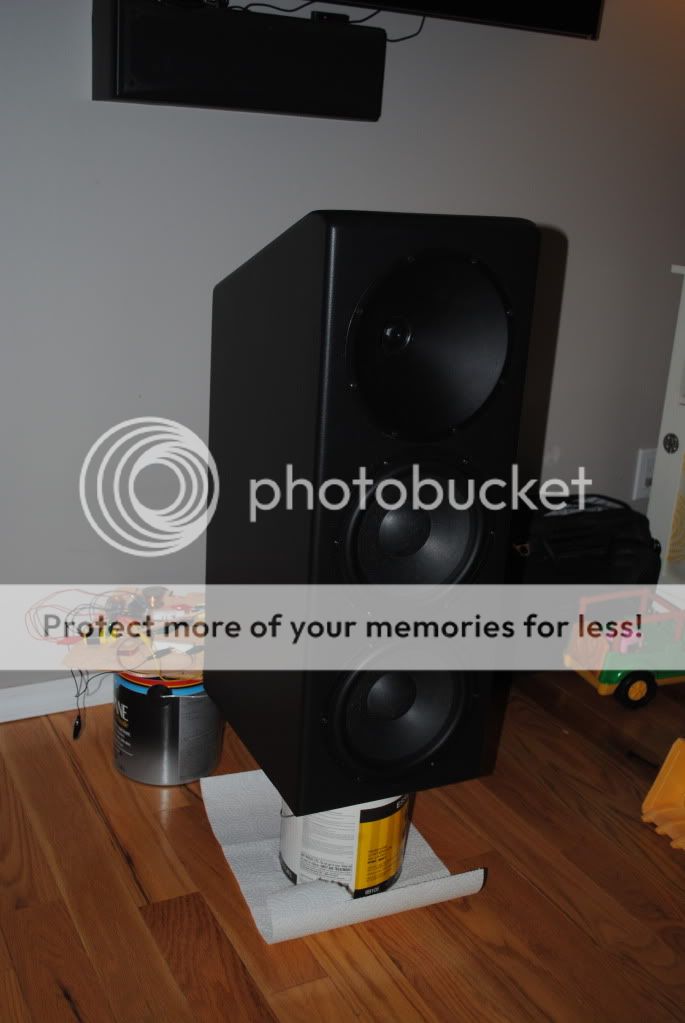
After (CSS)
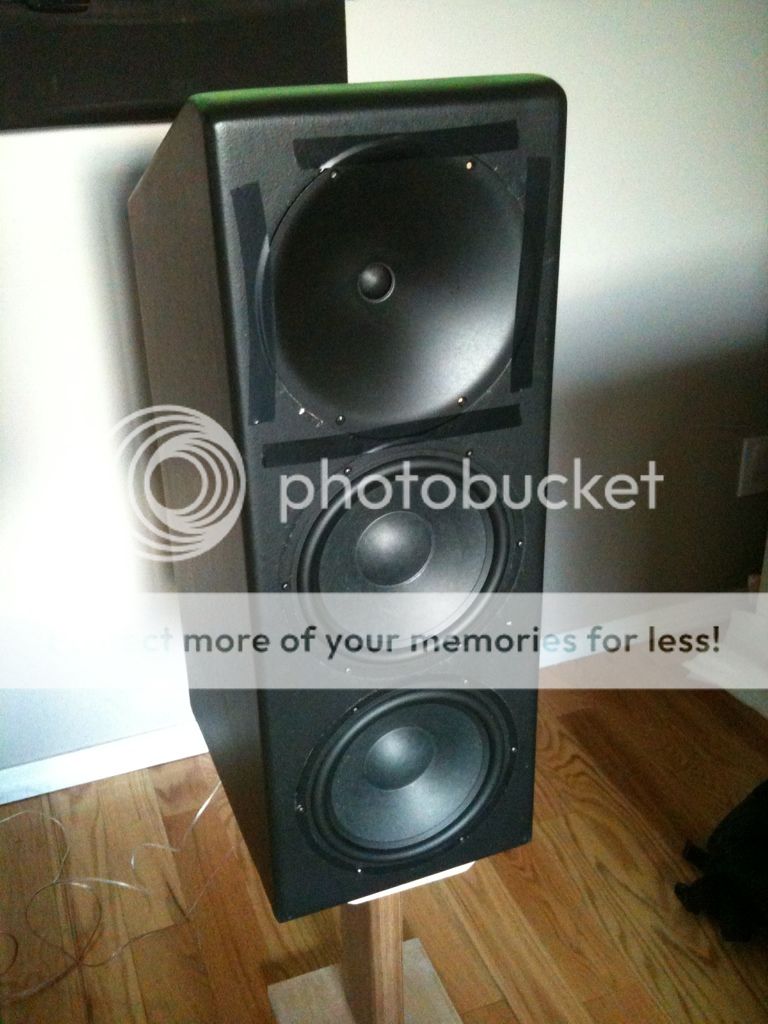
Might be hard to tell from the pictures, but the CSS looks a lot better.
I did some measuring and it's improves the LD25x... A LOT! I wasn't sure it bested the Dayton SB29 combo though, at least on paper. So I rigged up my minidsp.
The CSS/LD25x was given a 4500hz BW6db/oct high pass. That's it. No eq. That yielded a 1200hz LR24db/oct acoustic high pass. I worked the twin 8" silver flutes into a good LR4 at 1200hz low pass and dialed in delay. Ok, set. At least in a simulation.
Fired them up and listened to a fair bit of music and a couple movies.
Now the good stuff...
WOW! Well done CSS. This thing is really nice. I've been tweaking my Dayton SB29 combo for months and right out of the gate I'd take the CSS over the SB29. It's close though, but to think I haven't even tweaked.
An important factor is that the waveguide dramatically boosted sensitivity. More than I thought it would. It was singing along around 93db/2.83V/m. NICE! Granted so does the SB.
To describe the sound - smooth, clean, LD = low distortion... yup. Accurate.
Jeff Bagby has messed with this tweeter as well, and he's pointed out that this tweeter has a very clean CSD plot. My measurements have shown a very clean impulse response. I am now convinced this can be quite audible. That's exactly how it sounds. CLEAN. CLEAN. CLEAN.
Here's the unfiltered response in blue with a couple passive filters.
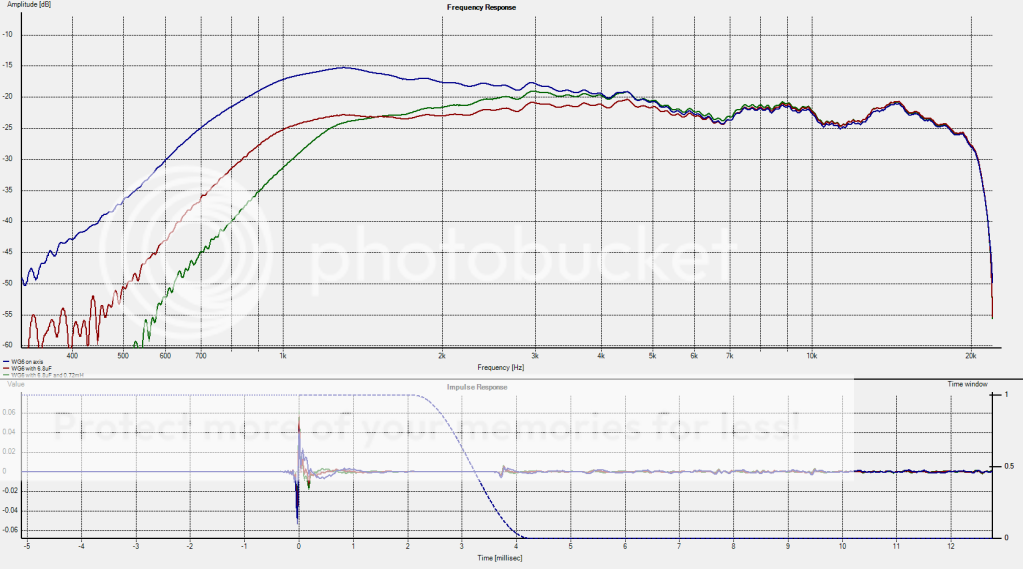
LD25x users... enjoy
Hey,
I've been playing with some waveguides from CSS (planned for production I believe) for the LD25x. Dave P over on Tech Talk developed them. I had a speaker that uses the Dayton 8" waveguide and SB29 tweeter. This waveguide was a direct drop in. Take a look:
Before (Dayton and SB29)

After (CSS)

Might be hard to tell from the pictures, but the CSS looks a lot better.
I did some measuring and it's improves the LD25x... A LOT! I wasn't sure it bested the Dayton SB29 combo though, at least on paper. So I rigged up my minidsp.
The CSS/LD25x was given a 4500hz BW6db/oct high pass. That's it. No eq. That yielded a 1200hz LR24db/oct acoustic high pass. I worked the twin 8" silver flutes into a good LR4 at 1200hz low pass and dialed in delay. Ok, set. At least in a simulation.
Fired them up and listened to a fair bit of music and a couple movies.
Now the good stuff...
WOW! Well done CSS. This thing is really nice. I've been tweaking my Dayton SB29 combo for months and right out of the gate I'd take the CSS over the SB29. It's close though, but to think I haven't even tweaked.
An important factor is that the waveguide dramatically boosted sensitivity. More than I thought it would. It was singing along around 93db/2.83V/m. NICE! Granted so does the SB.
To describe the sound - smooth, clean, LD = low distortion... yup. Accurate.
Jeff Bagby has messed with this tweeter as well, and he's pointed out that this tweeter has a very clean CSD plot. My measurements have shown a very clean impulse response. I am now convinced this can be quite audible. That's exactly how it sounds. CLEAN. CLEAN. CLEAN.
Here's the unfiltered response in blue with a couple passive filters.

LD25x users... enjoy
I applied a 4500 BW1 filter to achieve a 1200hz LR4 acoustic cross over. The high xo on the tweeter flattens the tweeter response back to how it should look, like my last screen shot. I wouldn't cross those silver flute 8" above 1500hz. Even at 1200hz it was obvious the tweeter was cleaner. This tweeter deserves comparable woofers. The SF are not.
I didn't do distortion plots because they don't mean anything without a lot of extra care in setup. I'd need 3 or 4 reference tweeters. And a way to control SPL for each tweeter. The effort isn't worth it to me.
I didn't do distortion plots because they don't mean anything without a lot of extra care in setup. I'd need 3 or 4 reference tweeters. And a way to control SPL for each tweeter. The effort isn't worth it to me.
Last edited:
The original goal that i proposed when Ryan took these away was to see if we could get them to match-up with the natural roll-off of a treated SDX7. The red curve. The tweeter with wave-guide goes so low we might have to choke back the top of the SDX7 a bit. Might well work in conjunction with flattening the top of its range.
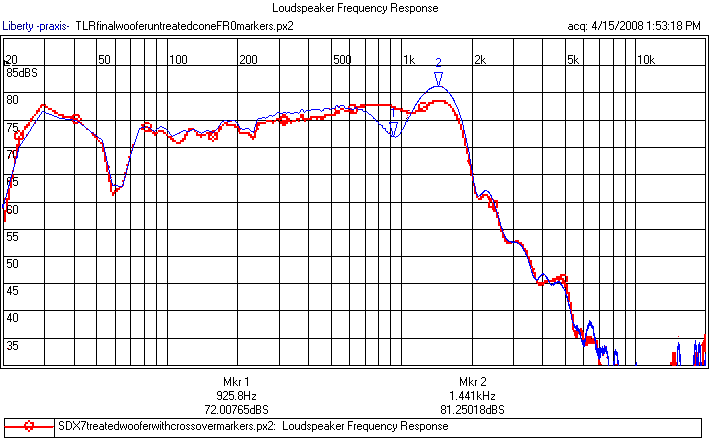
dave
dave
Attachments
- Status
- This old topic is closed. If you want to reopen this topic, contact a moderator using the "Report Post" button.
- Home
- More Vendors...
- CSS
- New Drivers: VWR126X and LD25X
